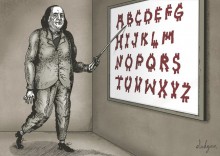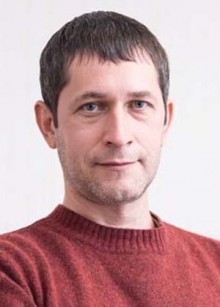Geeks and adventurous people all over the world have gone into cryptocurrencies, economists study this phenomenon and make predictions as to how serious it all is. Meanwhile, caricaturists, while observing the “crypto fever,” held a wittiness contest focusing on it. Recently, the 6th International Caricature Contest “Time Is Money 2018. Crypto-Currency: Bitcoin and Others” had its results announced, its organizers including the Caricaturist Association of Ukraine, the International Gogol Fantasy Arts Festival, NGOs and representatives of the BitClub Project financial company. Ukrainian Ihor Lukianchenko came out the first.
Long-standing readers of The Day may already know about Lukianchenko’s works, which were published in this newspaper for some time. Overall, he has won multiple caricature contests around the world. According to Lukianchenko, works by Ukrainian caricaturists often win prizes at international contests. This is despite the fact that the heyday of this genre in Ukraine has passed. Indeed, The Day also feels it, because we are among the few publications that regularly publish caricatures and treat it as an independent journalistic genre. It takes a lot of time to search for apt pictures, and today we often turn to Russian caricaturist Viktor Bogorad. Lukianchenko shared his perspective on the situation in a conversation with The Day.
“UKRAINIAN CARICATURISTS ARE AMONG THE STRONGEST IN THE WORLD”
Authors from many countries took part in the cryptocurrency-themed caricature contest. What are your impressions of their works?
“Indeed, this was an international contest, and submissions came from a few dozen countries. The second position went to a Croatian participant, and the third was occupied by an author from Syria. Contest entries were quite strong, and 28 of them have been included in the catalog, which is currently being printed.”
However, you are the only Ukrainian among the winners.
“Nonetheless, quite a lot of Ukrainian artists have made it to the catalog. In general, Ukrainian caricaturists are among the strongest in the world. If you take international contests that are held around the world, and there are about a hundred of them, Ukrainian artists, as a rule, win a lot of prize positions in them. For example, last year I alone received a dozen prizes at international caricature contests, of which four were for the first places, namely in Iran, Croatia, Hungary, and Belgium.”
People do not commonly associate Iran with caricature contests.
“This is a misleading thought. Today’s Iran can be said to be going through a caricature boom, maybe similar to what we had in Ukraine 20 or 30 years ago. There are quite a lot of caricature contests being held there, there are many strong Iranian artists who have started to win prizes at European contests. So, there is a lot of interest in the caricature there. It applies to Syria and other Arab countries as well, but also to non-Arab ones. For example, China and the rest of its region have the same situation.”
Can it be due to certain political events? I mean the situation when the life itself, so to say, offers more subjects for ironic treatment.
“It is unlikely. In principle, the political situation and events are approximately the same, of the same type at all times. Probably this is due to the fact these countries’ time has come.”
“WITH THE DEMISE OF PRINTED PRESS, THE UKRAINIAN CARICATURE HAS ALSO FADED A BIT”
You mentioned that Ukraine had a caricature boom some 20 to 30 years ago. How did it manifest itself?
“Then the genre was just starting to develop, I mean the ironic graphics. There were caricature contests, more and more of them in Europe. Ukrainian artists began to take part in them and receive prizes. In principle, they began to do so even before the Soviet period ended. At that time, many artists were forbidden to take part in such contests, so they transported their works to Europe illegally. And when the Soviet Union collapsed and freedom came, authors began to actively send works abroad, new artists began to appear, and the Kyiv Arkhigum Caricaturist Club emerged, which is already famous now. This club was organized by Viktor Kudin, today he is a well-known caricaturist and very well-known architect, Volodymyr Kazanevskyi, who is a globally well-known caricaturist, Anatolii Kazanskyi, who died tragically, and Yurii Kosobukin, who died relatively recently, he was the most famous caricaturist in the world by the number of awards [he is listed in the Guinness Book of Records as the artist with the largest number of awards in international caricature contests. – Author]. There was a surge of the caricature, which lasted for 20 years, until the global economic crisis of 2008. And then the number of print media began to decrease, and they were where, basically, caricaturists got published. With the demise of printed press, the Ukrainian caricature has also faded a bit. All remaining Ukrainian caricature artists mostly work for international contests now.
“The caricaturist has almost no platform other than print media. Modern media, of course, use caricature, but they try to pay nothing due to the specifics of the electronic environment. It was newspapers and magazines that paid for caricatures.”
Coming back to Kazanskyi who worked for Den/The Day and whose works still get published on our front pages, in your opinion, what was special about his style?
“Kazanskyi’s technique was special in that he mixed the caricature and surrealism. I do not even know who he can be compared to. His technique was so unique that no one would repeat it.
“It is a pity that he passed away so early. He could have created many more brilliant works. Incidentally, the album of his caricatures which has been published by Den/The Day is very good in my opinion, both in format and in the works that have got entered there.”
“THERE ARE PRACTICALLY NO NEW YOUNG ARTISTS”
You mentioned the milieu that was being formed 30 years ago. Has a new generation of Ukrainian caricaturists appeared?
“As far as I know, we will soon enter what may be called a demographic trough among caricaturists. Since there is no demand for caricature in Ukraine, it is natural that there are no new artists, no one draws caricatures. And in order to become a good caricaturist, one has to draw a lot, to spend time on it and, of course, it is desirable to receive some money in order to survive for that time. No one will do caricatures for nothing. There are practically no new young artists. I do not know even one.”
You also cooperated with Den/The Day. And it concerned not only caricatures, as your humorous text sketches also appeared in the newspaper. Do you write now?
“There are some texts, but I do not publish them anywhere. If something comes on my mind, I write it down, give it a graphic form sometimes. It would be possible to post it on Facebook, but, like with the caricature, there are actually next to no platforms for verbal humor. Again, while almost all the newspapers had columns of humor and caricatures on their last pages before, I do not know where it can be published today.
“In general, humor and satire are in very high demand with people. But they are absent from large platforms. Facebook, for example, is ‘scattered,’ many authors simply post their works there, but this only spreads among friends, maybe several hundred people will read it.”
“UKRAINIAN POLITICIANS MAKE GOOD CARICATURE TARGETS ALL THE TIME”
Do you have any themes on which you would not draw a caricature?
“Such topics may exist, not specifically for the caricature, but for the press in general, and they commonly include religion, death, subjects that affect the feelings of a certain group of people. Although... The caricature is a genre that, by and large, can wrap any topic in such a form that it will not cause a harsh reaction. If you look at the French caricature, there are no taboos there at all, like in the Charlie Hebdo magazine. In Ukraine, the caricature is a little more smoothed out, less biting.”
What is the reason for it?
“If you consider the editorial caricature, everything is clear about it. All media are owned by certain financial groups. Naturally, they express the interests of these groups. The entire editorial policy is being built based on these interests. It applies to the caricature as well. It is unlikely that they will ever publish biting caricatures that target the government or something like that, given that almost all the newspapers are in some way connected, for example, with the government.”
Are modern Ukrainian politicians of interest to you as caricature characters?
“Any political figure is of interest to me if they make a good caricature target. And given that our politicians make good caricature targets all the time, it is natural that the Ukrainian political class is of interest to caricaturists as they can be graphically depicted in an ugly light.”








